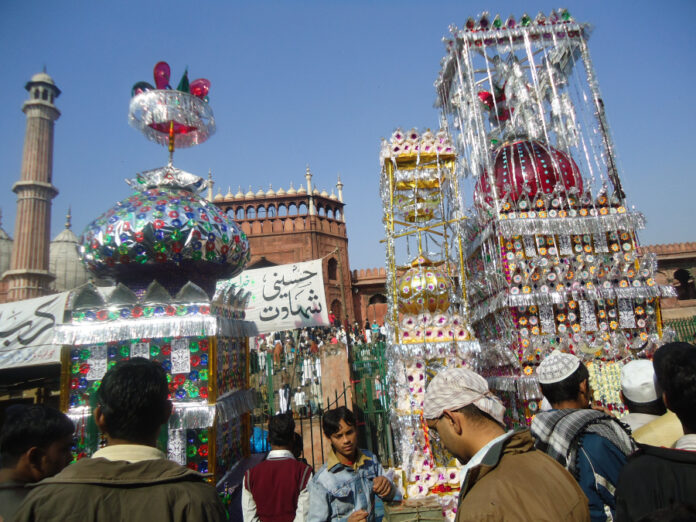LAHORE: In the Holy Quran, Allah assures human kind in the Surah Al-Isra that the truth has arrived and falsehood has vanished; indeed falsehood had to vanish.
The Holy Quran is the sole resource of humanity that calls and leads people to the correct knowledge of Allah, the values of Islam, how to live in a way that pleases Allah, and a concise criterion that distinguishes right from wrong.
For this reason, one of the Holy Quran’s names is “Furqan”- one that distinguishes right from the wrong.
The golden saying of Imam Ali Ibn Abi Talib (AS) reads “a society can survive with disbelief (kufr), but not with injustice”.
With the arrival of Muharram, Shia Muslims across the world mourn the martyrdom of the Holy Prophet’s (Peace Be Upon Him) grandson, Imam Hussain (AS), his family members and the companions by taking out tazia (model of Imam’s Hussain’s (AS) shrine), Zuljinah and Alam processions.
Imam Hussain (AS) was martyred in the year 680 (AD), in a brutal massacre on the plains of Karbala by the then-ruler Yazid’s forces. To save the spirit of Islam, Imam Hussain (AS) had refused to pledge allegiance to Yazid, which resulted in the tragedy of Karbala.
Since then, to commemorate the great sacrifices of Imam Hussain (AS), his family and his companions, mourning processions are taken out in many parts of the world, during the first 10 days (Ashra Ashur) of the holy month of Muharram.
The Tazia is a replica of the shrine of Imam Hussain (AS). The takht (base of tazia) is the first artifact (piece) to be carried out on day one, followed by the palanquin and finally, the jhoola.
Then it is reconstructed on the 10th day called Yum-e-Ashur. Pakistan is not only a very large country in terms of area, but it is remarkable for the diversity of cultures, languages and multi-religiosity that flourishes here.
It is also a country with a rich aesthetic tradition as evinced by our local crafts.
Tazias are displayed in the mourning processions, and are mostly manufactured in Chiniot, Multan, Faisalabad, Lahore and Rawalpindi.
Among these, the famous tazias are of Chiniot and Multan.‘Taziyadari’ is a central part of the Muharram mourning tradition in all parts of the country, to show respect and to mark Imam Hussain’s (AS) martyrdom every year on the 10th of Muharram.
As the manufacturing market of the art, Multan and Chiniot are the most famous and the most ancient and historical cities of Pakistan. In Chiniot people are adept in wood-craft and architectural marvels.
With the oldest tazia tradition in the subcontinent, Multan leads among Lahore, Rawalpindi Chiniot and Faisalabad.
The tazias constructed in Multan are considered to be the beautiful, tallest and masterpiece handcrafts in the entire sub-continent.
Talking to APP, Shahzeb Hassan, the licence holder of the famous Ustaad Wala Tazia in Multan said that more than 112 tazia processions were taken out on the 10th of Muharram in Multan every year. ‘Ustaad Wala Tazia’ was crafted by Ustaad Pir Bukhsh, who started work on it in 1810 and completed its structure in 15 years, in 1825.
Hassan said that Teak wood was used in the structure and it was built without the use of even a single nail anywhere. It takes at least seven hours to reach its final destination on Shah Risal Road on the 10th of Muharram after travelling a distance of 2.5 kilometres,” Hassan said.
It is worth mentioning here that the Ustaad Wala Tazia leads all mourning processions in Multan whereas the ‘Shagird Wala Tazia’ follows it close behind, symbolising a student’s respect for his teacher.
Licence holder of Shagird Wala Tazia, Muhammad Raees, while giving the details about the tazia, told APP that 32-feet-high, weighing around 4,000 kilograms, the masterpiece was constructed by Salman Ali, one of Pir Bukhsh’s students in 1854. Raees said that at least 200 people are required to carry the tazia on the 10th of Muharram, adding that they place it at the top of the ‘Khooni Burj’ for everyone to take a look at it easily.
Another famous Sakhi Lal Shah Tazia in Multan is at least 248 years old, and is among the oldest tazia processions of South Punjab, which is taken out every year to commemorate the 10th of Muharram, said Makhdoom Hassan Raza Mashhadi. Raza, who is the current caretaker of Pir Syed Lal Shah Al-Mosvi Al Mashhadi shrine told APP that his forefather Pir Syed Lal Shah laid the foundation of the Safavi dynasty in Iran and was the founder of the tazia culture in the sub-continent.
“Our ancestors arrived in Multan in 1820 AD and established an Imambargah at the western bank of River Ravi, and he is considered as the founder of the mourning tradition in the sub-continent,” he said.
Although the art of making tazias has become a commercial profession, a great deal of history remains embedded therein, said Ali Hassan Pirjah, a member of the Pirjah family in Chiniot while talking to APP.
It may be mentioned here that Chinioti Tazia art master Ilahi Bakhsh, had commissioned the decoration of a portion of Buckingham Palace. Bakhsh’s grandson Akhtar Pirjah, has also been requested by various royal Arab states to construct wooden interior structures for their family mansions. He said that the nine famous tazias of Chiniot are Peer Shadi Malang, Charrhoyan, Kamangaran, Masharqi Thathi, Magarbi Thathi, Koobay Shah, Qazian, Qasayan and Aali. They were precious not only in terms of cost but were considered masterpieces of art, and were carefully dismantled and stored for the following year, Hassan said. Akhtar Pirjah has earned a rich appreciation and identity in the holy art works with the serenity of being known globally, he has done justice by preserving the legacy of his family, Hassan concluded.
One of the more interesting tazias in Pakistan is Buraq Wala Tazia in Hyderabad. It is named after ‘Buraq’ horse that carried the Holy Prophet (PBUH) to the heavens. This is the only tazia in the country that incorporates a human face in it.























